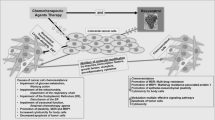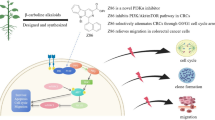Abstract
Raf-1 kinase inhibitory protein (RKIP) acts as a tumor cell metastasis suppressor and prognostic indicator for survival in various cancers. Its use is predicted to improve therapy for various malignancies, including colorectal cancer (CRC). RKIP, frequently denoted as phosphatidylethanolamine-binding protein 1, is expressed in all normal mammalian tissues. RKIP functions as an inhibitor of the Raf-1, PI-3K, and MAP kinase (MAPK) pathways. In this study, we found that resveratrol induced the expression of RKIP at protein levels. To elucidate the structural basis of the interaction between resveratrol and RKIP, we performed computational studies that explore the binding affinity and ligand efficacy of resveratrol against RKIP. This study reveals the prognostic significance of RKIP metastasis suppressor activity against CRC and its structural arrangements during drug–target interactions.


Similar content being viewed by others
Abbreviations
- AA:
-
Amino acids
- CASTp:
-
Computed Atlas of Surface Topography of Proteins
- COX-2:
-
Cyclooxygenase-2
- CRC:
-
Colorectal cancer
- GPCR:
-
G protein-coupled receptor
- GRK2:
-
G protein-coupled receptor kinases
- HPV:
-
Human papillomavirus
- iNOS:
-
Inducible nitric oxide synthase
- MAPK:
-
Mitogen-activated protein kinases
- MMP:
-
Matrix metalloproteinases
- NF-κB:
-
Nuclear factor kappa B
- PDB:
-
Protein Data Bank
- PEBP1:
-
Phosphatidylethanolamine-binding protein
- PGE2:
-
Prostaglandin E2
- PKC:
-
Protein kinase C
- PPARα:
-
Peroxisome proliferator-activated receptor α
- ProSA:
-
Protein structure analysis
- PTEN:
-
Phosphatase and tensin homolog
- PTK:
-
Protein tyrosine kinase
- pTyr:
-
Phospho tyrosine
- QMEAN:
-
Qualitative model energy analysis
- RCSB:
-
Research Collaboratory for Structural Bioinformatics
- RKIP:
-
Raf-1 kinase inhibitory protein
- SIRT1:
-
Sirtuin
- SMILES:
-
Simplified molecular input line entry System
- STAT:
-
Signal transducer and activators of transcription
- VEGF:
-
Vascular endothelial growth factor
References
Al-Mulla F, Hagan S, Behbehani AI, Bitar MS, George SS, Going JJ, García JJC, Scott L, Fyfe N, Murray GI (2006) Raf kinase inhibitor protein expression in a survival analysis of colorectal cancer patients. J Clin Oncol 24(36):5672–5679
Al-Mulla F, Bitar MS, Al-Maghrebi M, Behbehani AI, Al-Ali W, Rath O, Doyle B, Tan KY, Pitt A, Kolch W (2011) Raf kinase inhibitor protein RKIP enhances signaling by glycogen synthase kinase-3β. Cancer Res 71(4):1334–1343
Atmanene C, Laux A, Glattard E, Muller A, Schoentgen F, Metz-Boutigue M-H, Aunis D, Van Dorsselaer A, Stefano GB, Sanglier-Cianferani S (2009) Characterization of human and bovine phosphatidylethanolamine-binding protein (PEBP/RKIP) interactions with morphine and morphine-glucuronides determined by noncovalent mass spectrometry. Med Sci Monit 15(7):BR178–BR187
Banaganapalli B, Mulakayala C, Gowsia D, Mulakayala N, Pulaganti M, Shaik NA, Anuradha C, Rao RM, Al-Aama JY, Chitta SK (2013) Synthesis and biological activity of new resveratrol derivative and molecular docking: dynamics studies on NFkB. Appl Biochem Biotechnol 171(7):1639–1657
Battaini F, Mochly-Rosen D (2007) Happy birthday protein kinase C: past, present and future of a superfamily. Pharmacol Rese Off J Ital Pharmacol Soc 55(6):461
Benkert P, Tosatto SC, Schomburg D (2008) QMEAN: a comprehensive scoring function for model quality assessment. Proteins Struct Funct Bioinform 71(1):261–277
Berretta M, Bignucolo A, Di Francia R, Comello F, Facchini G, Ceccarelli M, Iaffaioli RV, Quagliariello V, Maurea N (2020) Resveratrol in cancer patients: from bench to bedside. Int J Mol Sci 21(8):2945
Dadvar P, Kovanich D, Folkers GE, Rumpel K, Raijmakers R, Heck AJ (2009) Phosphatidylethanolamine-binding proteins, including RKIP, exhibit affinity for phosphodiesterase-5 inhibitors. ChemBioChem 10(16):2654–2662
Fang J-Y, Li Z-H, Li Q, Huang W-S, Kang L, Wang J-P (2012) Resveratrol affects protein kinase C activity and promotes apoptosis in human colon carcinoma cells. Asian Pac J Cancer Prev 13(12):6017–6022
Fu Z, Smith PC, Zhang L, Rubin MA, Dunn RL, Yao Z, Keller ET (2003) Effects of raf kinase inhibitor protein expression on suppression of prostate cancer metastasis. J Natl Cancer Inst 95(12):878–889
Gambini J, Inglés M, Olaso G, Lopez-Grueso R, Bonet-Costa V, Gimeno-Mallench L, Mas-Bargues C, Abdelaziz K, Gomez-Cabrera M (2015) Vina J (2015) Properties of resveratrol: in vitro and in vivo studies about metabolism, bioavailability, and biological effects in animal models and humans. Oxid Med Cell Longev. 2015:837042. https://doi.org/10.1155/2015/837042 (Epub 2015 Jun 28)
Granovsky AE, Clark MC, McElheny D, Heil G, Hong J, Liu X, Kim Y, Joachimiak G, Joachimiak A, Koide S (2009) Raf kinase inhibitory protein function is regulated via a flexible pocket and novel phosphorylation-dependent mechanism. Mol Cell Biol 29(5):1306–1320
Guo C, Chang T, Sun T, Wu Z, Dai Y, Yao H, Lin D (2018) Anti-leprosy drug Clofazimine binds to human Raf1 kinase inhibitory protein and enhances ERK phosphorylation. Acta Biochim Biophys Sin 50(10):1062–1067
Hu C-j, Zhou L, Cai Y (2014) Dihydroartemisinin induces apoptosis of cervical cancer cells via upregulation of RKIP and downregulation of bcl-2. Cancer Biol Ther 15(3):279–288
Kopp P (1998) Resveratrol, a phytoestrogen found in red wine. A possible explanation for the conundrum of the ‘French paradox’? Eur J Endocrinol 138(6):619–620
Kuipers EJ, Grady WM, Lieberman D, Seufferlein T, Sung JJ, Boelens PG, van de Velde CJ, Watanabe T (2015) Colorectal cancer. Nat Rev Dis Primers 1:15065. https://doi.org/10.1038/nrdp.2015.65
Kumar S, Jena L, Sahoo M, Kakde M, Daf S, Varma AK (2015) In silico docking to explicate interface between plant-originated inhibitors and E6 oncogenic protein of highly threatening human papillomavirus 18. Genom Inform 13(2):60
Laskowski RA, Swindells MB (2011) LigPlot+: multiple ligand–protein interaction diagrams for drug discovery. ACS Publications, Washington
Li F-F, Song S-J, Zhang R-N (2009a) Phosphatidylethanolamine-binding protein (PEBP) in basic and clinical study. Sheng li ke xue jin zhan [Prog Physiol] 40(3):214–218
Li HZ, Gao Y, Zhao XL, Liu YX, Sun BC, Yang J, Yao Z (2009b) Effects of raf kinase inhibitor protein expression on metastasis and progression of human breast cancer. Mol Cancer Res 7(6):832–840
Lorenz K, Lohse MJ, Quitterer U (2003) Protein kinase C switches the Raf kinase inhibitor from Raf-1 to GRK-2. Nature 426(6966):574
Nagaraju GP, Long TE, Park W, Landry JC, Taliaferro-Smith L, Farris AB, Diaz R, El-Rayes BF (2015) Heat shock protein 90 promotes epithelial to mesenchymal transition, invasion, and migration in colorectal cancer. Mol Carcinog 54(10):1147–1158
Pany S, Majhi A, Das J (2012) PKC activation by resveratrol derivatives with unsaturated aliphatic chain. PLoS One 7(12):e52888
Park D, Jeong H, Lee MN, Koh A, Kwon O, Yang YR, Noh J, Suh P-G, Park H, Ryu SH (2016) Resveratrol induces autophagy by directly inhibiting mTOR through ATP competition. Sci Rep 6:21772
Pathak RK, Baunthiyal M, Taj G, Kumar A (2014) Virtual screening of natural inhibitors to the predicted HBx protein structure of Hepatitis B Virus using molecular docking for identification of potential lead molecules for liver cancer. Bioinformation 10(7):428
Pervaiz S (2003) Resveratrol: from grapevines to mammalian biology. FASEB J 17(14):1975–1985
Pontius J, Richelle J, Wodak SJ (1996) Deviations from standard atomic volumes as a quality measure for protein crystal structures. J Mol Biol 264(1):121–136
Shemon AN, Eves EM, Clark MC, Heil G, Granovsky A, Zeng L, Imamoto A, Koide S, Rosner MR (2009) Raf Kinase Inhibitory Protein protects cells against locostatin-mediated inhibition of migration. PLoS One 4(6):e6028
Siegel RL, Miller KD, Jemal A (2020) Cancer statistics, 2020. CA Cancer J Clin 70(1):7–30
Simister PC, Burton NM, Brady RL (2011) Phosphotyrosine recognition by the Raf kinase inhibitor protein. In: Forum on immunopathological diseases and therapeutics, 2011, vol 1. Begel House Inc., New York, pp 59–70. https://doi.org/10.1615/ForumImmunDisTher.v2.i1.70
Slater SJ, Seiz JL, Cook AC, Stagliano BA, Buzas CJ (2003) Inhibition of protein kinase C by resveratrol. Biochim Biophys Acta Mol Basis Dis 1637(1):59–69
Stewart JR, Ward NE, Ioannides CG, O’Brian CA (1999) Resveratrol preferentially inhibits protein kinase C-catalyzed phosphorylation of a cofactor-independent, arginine-rich protein substrate by a novel mechanism. Biochemistry 38(40):13244–13251
Sun AY, Simonyi A, Sun GY (2002) The “French Paradox” and beyond: neuroprotective effects of polyphenols. Free Radic Biol Med 32(4):314–318
Takizawa Y, Nakata R, Fukuhara K, Yamashita H, Kubodera H, Inoue H (2015) The 4′-hydroxyl group of resveratrol is functionally important for direct activation of PPARα. PLoS One 10(3):e0120865
Thakkar K, Geahlen RL, Cushman M (1993) Synthesis and protein-tyrosine kinase inhibitory activity of polyhydroxylated stilbene analogs of piceatannol. J Med Chem 36(20):2950–2955
Tohdoh N, Tojo S, Agui H, Ojika K (1995) Sequence homology of rat and human HCNP precursor proteins, bovine phosphatidylethanolamine-binding protein and rat 23-kDa protein associated with the opioid-binding protein. Mol Brain Res 30(2):381–384
Vastano BC, Chen Y, Zhu N, Ho C-T, Zhou Z, Rosen RT (2000) Isolation and identification of stilbenes in two varieties of Polygonum cuspidatum. J Agric Food Chem 48(2):253–256
Wallner B, Elofsson A (2006) Identification of correct regions in protein models using structural, alignment, and consensus information. Protein Sci 15(4):900–913
Wang Y, Catana F, Yang Y, Roderick R, van Breemen RB (2002) An LC-MS method for analyzing total resveratrol in grape juice, cranberry juice, and in wine. J Agric Food Chem 50(3):431–435
Wang Y, Wang L-Y, Feng F, Zhao Y, Huang M-Y, Shao Q, Chen C, Sheng H, Chen D-L, Zeng Z-L (2015) Effect of Raf kinase inhibitor protein expression on malignant biological behavior and progression of colorectal cancer. Oncol Rep 34(4):2106–2114
Wiederstein M, Sippl MJ (2007) ProSA-web: interactive web service for the recognition of errors in three-dimensional structures of proteins. Nucleic Acids Res 35(suppl_2):W407–W410
Yeung K, Seitz T, Li S, Janosch P, McFerran B, Kaiser C, Fee F, Katsanakis KD, Rose DW, Mischak H (1999) Suppression of Raf-1 kinase activity and MAP kinase signalling by RKIP. Nature 401(6749):173
Yousuf S, Duan M, Moen EL, Cross-Knorr S, Brilliant K, Bonavida B, LaValle T, Yeung KC, Al-Mulla F, Chin E (2014) Raf kinase inhibitor protein (RKIP) blocks signal transducer and activator of transcription 3 (STAT3) activation in breast and prostate cancer. PLoS One 9(3):e92478
Funding
None.
Author information
Authors and Affiliations
Contributions
Data processing: BD, SKB, GS, AA and GPN. Study design: BD, SA, AA and GPN. Experimental studies: BD, SKB, GS, GC, SA, and AA. Manuscript editing: BD, GS, GC, SA, AA and GPN.
Corresponding author
Ethics declarations
Conflict of interest
The authors declare that they have no competing interest.
Ethical approval
Not applicable.
Consent to participate
Not applicable.
Consent for publication
Not applicable.
Additional information
Handling Editor: A. G. de Brevern.
Publisher's Note
Springer Nature remains neutral with regard to jurisdictional claims in published maps and institutional affiliations.
Rights and permissions
About this article
Cite this article
Dariya, B., Behera, S.K., Srivani, G. et al. Resveratrol binds and activates RKIP protein in colorectal cancer. Amino Acids 52, 1299–1306 (2020). https://doi.org/10.1007/s00726-020-02889-2
Received:
Accepted:
Published:
Issue Date:
DOI: https://doi.org/10.1007/s00726-020-02889-2




